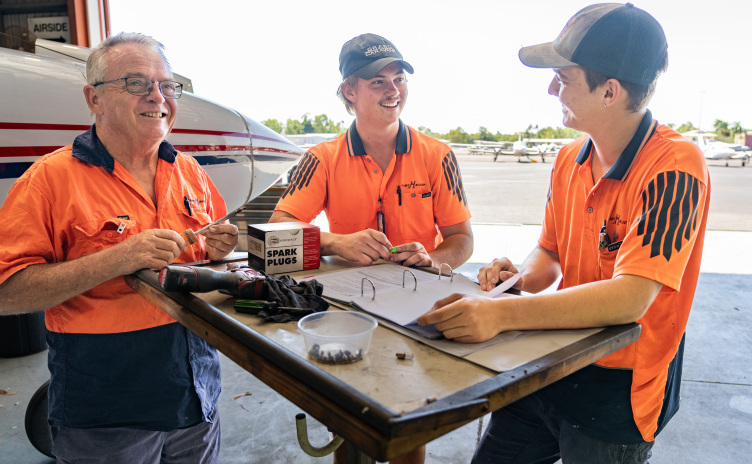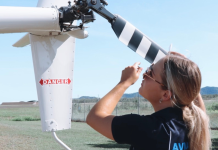What this toolbox talk covers:
- Safety culture and just culture: what are they and why they’re important
- Safety reporting: keeping the health of your safety culture in check
- Managers, supervisors and staff: what role do each play in developing, maintaining and upholding an organisation’s safety culture
- Discussion scenarios: a chance to get you thinking about safety and your own experiences
What is safety culture?
Safety culture is ‘the way we do business around here’. An organisation that has a positive safety culture undertakes its work in a safe, collaborative, procedural and compliant manner.
In the maintenance sector, there are a number of factors that can cause us stress on any given day. This might arise from staff shortages, introducing a new aircraft, or absorbing CASA regulations. It is important to remember that despite factors that slow us down, a high standard of safety and compliance must be maintained, even when faced with adversity. This is the true measure of a team’s or an organisation’s safety culture.
Where does safety culture start?
Safety culture and its required outcomes should be communicated by the CEO and managers to employees from day one.
Statements around safety culture and other directives must be made clear to all new employees through their induction training, and should be championed by supervisors, workshop, store, ground and office staff to generate a positive safety culture.
However, all employees play a part towards contributing and maintaining the safety standards set.
What type of things contribute towards safety culture?
- Management actions and priorities: does the organisation have a safety statement and is it promoted throughout the company?
- Policies and procedures: are policies and procedures documented in company manuals and are they readily accessible if workers need to find them?
- Supervisory practices: do management and supervisors set the appropriate tone for workers?
- Safety goals and planning: what are your personal safety goals and how can they be achieved?
- Responses to unsafe behaviour: how does the company handle unsafe behaviour? Does the organisation provide and promote incident reporting?
- Employee training and motivation: how can employees find out about new safety topics? Are there programs that workers can access that provide important safety updates and information, and is this refreshed regularly?
- Employee involvement and ownership: how much buy-in do employees have into safety priorities of the company? Do all workers go to work with the mindset of upholding safety every day?
What is just culture?
Just culture means that individuals are not blamed for honest errors they may make in their work.
Penalties against workers are only applied when there is clear evidence of a conscious violation or intentional, reckless or negligent behaviour, like purposely ignoring a policy, procedure or regulation.
Safety reporting
Organisations with a just culture foster an atmosphere of trust where people are encouraged to speak up and report safety-related information if they are involved or witness it, without fear of punishment.
Reporting allows maintenance personnel to identify risks, improve safety protocols, ensure regulatory compliance, and make informed decisions that enhance operational efficiency.
Discussion scenario 1 – Safety culture
You’re an apprentice at an approved maintenance organisation (AMO) in regional South Australia, servicing various general aviation aircraft. On a Friday afternoon, your team is completing a 100-hourly inspection on a Cessna 210 used for charter. The aircraft is overdue, and the operator is pressuring for it to be released before the weekend.
You notice unusual wear on the rudder cable – still within limits but close. Replacing it would delay the aircraft another 2-3 days, and no spare is in stock. The senior LAME decides to note it as “within limits” and monitor it at the next inspection.
You feel uneasy but stay quiet to avoid causing delays or tension. The cable isn’t replaced, and the aircraft is returned to service.
Discussion questions:
- What elements of safety culture are highlighted in this scenario? Can you identify the strengths and weaknesses?
- How could you, as the apprentice, have approached your concern with the senior LAME’s decision not to replace the rudder cable?
- What pressures are smaller maintenance organisations under that may impact safety decision-making?
- Apply this scenario to your own organisation. What are some ways your AMO can balance commercial commitments and safety commitments?
Discussion scenario 2 – Reporting
You and your friend Jack work for a small AMO. You’re both thorough and went through TAFE together. Most safety issues in the team are handled informally and only documented if considered serious.
During a routine inspection of a Piper PA-31, you find a slightly loose fuel drain valve from a previous job. There’s no leak, and the aircraft has flown several times since. You tighten it and mention it to Jack, who admits he forgot it. You both laugh it off.
Later, you consider filing a report but decide not to – you don’t want to make it official or get Jack in trouble.
Weeks later, a similar issue causes a minor fuel leak and delays a charter flight. During the morning briefing, you mention the earlier incident. Your boss looks shocked – it’s the first he’s heard of it.
Discussion questions:
- What are potential consequences for not reporting ‘minor’ safety issues?
- What could be some reasons as to why workers might not report an issue like this, even when they know a problem has been identified?
- In this example, what can management do to encourage reporting, even for seemingly minor maintenance issues?
- Apply this scenario to your own organisation. Would you submit a report for this occurrence? Does your AMO provide training on how to submit a safety report, and can you identify where to access it?
Discussion scenario 3 – Just culture
You’re an aircraft maintenance engineer (AME) working on a Bell 407. While removing the main rotor hub fairing, your tool slips and you accidentally drop a fastener into the upper fuselage bay. You hear it bounce but can’t locate it. Embarrassed and not wanting to delay the job, you replace it with another fastener without reporting the incident.
The supervising LAME, busy with other tasks, signs off the job without a detailed check.
Weeks later, another technician finds the missing fastener lodged near the tail rotor drive shaft during an inspection. No damage occurred, but it could have been serious.
An internal review is launched. You admit what happened, sparking debate – some say it was a simple mistake; others believe disciplinary action is needed.
Discussion questions:
- What is just culture and how does it apply in this scenario?
- What’s the difference between a mistake and intentional non-compliance?
- What can the management team of this AMO do to promote learning and accountability and what role do they play in setting the tone for how mistakes are handled?
- Apply this scenario to your own organisation. If this was your colleague, do you think they should be disciplined? Why or why not?
Final questions to consider
- Where do you think your next incident or accident is going to come from?
- How do you know this?
- What are you, both as an individual and as an employee of an organisation, doing to report and address safety issues so that when you leave the house each morning, you know you’ll be returning at night?
Further reading
- May-tenance Month – Speak up: Building a reporting culture that works webinar – YouTube
- Safety Behaviours: Human Factors for Engineers resource kit – CASA website





